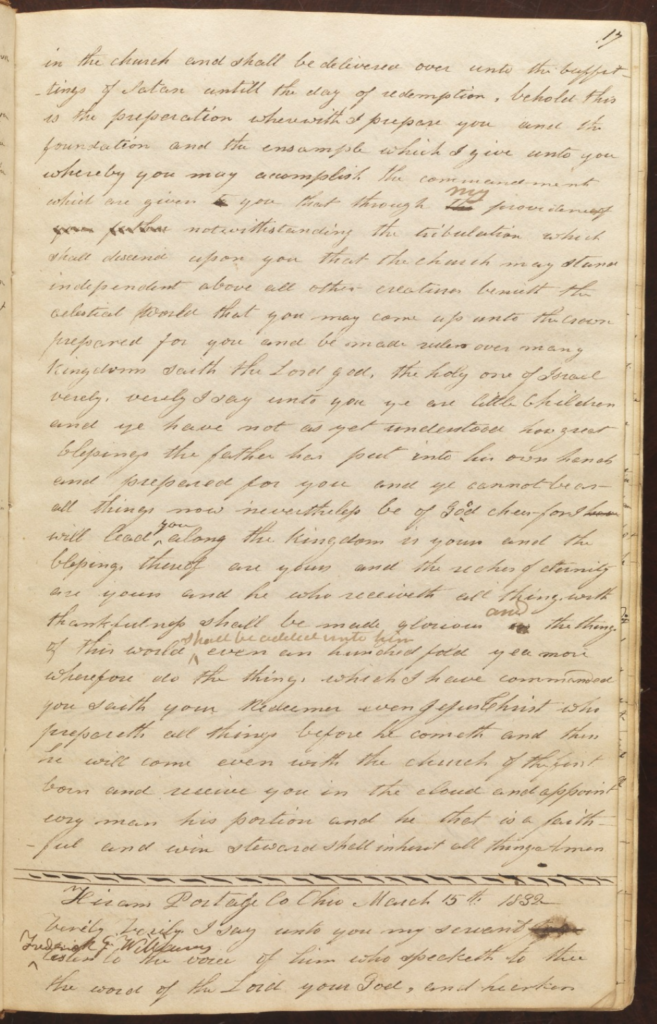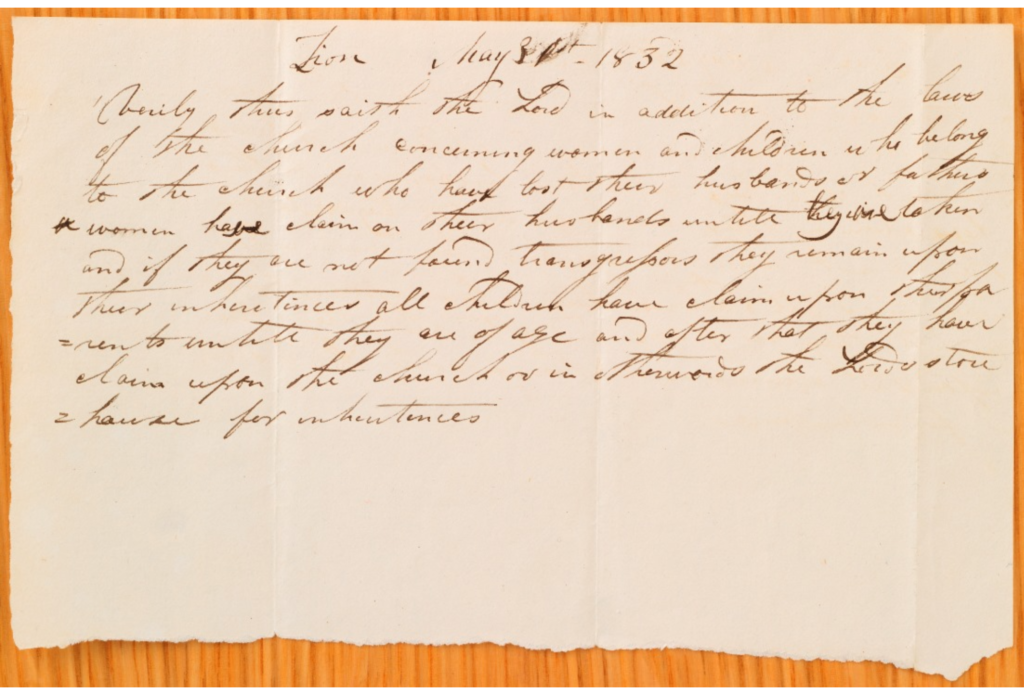Section 81

It is very good to have your sins blotted out. It is not good to have you name blotted out. Before erasers and delete keys, scribes used a blot of heavy ink to expunge the record. God keeps meticulous records. In them he blots out the sins of the repentant and the names of the rebellious unrepentant (Isaiah 44:22, Nehemiah 4:5, Alma 6:3, Moroni 6:7, D&C 109:34).
Joseph chose and ordained Jesse Gause as a counselor in the presidency of the high priesthood in March 1832.[1] A week later Joseph received Section 81, giving Jesse instructions for his calling.[2]
Section 81 announces that the keys of the kingdom belong to the Presidency of the High Priesthood. The Lord commands Jesse to “be faithful; stand in the office which I have appointed unto you; succor the weak, lift up the hands which hang down, and strengthen the feeble knees” (D&C 81:5). The Lord promises to bless Jesse on the specific conditions that he remain faithful, pray always, and proclaim the gospel. The revelation closes with a reiteration of the Lord’s covenant with Jesse: “If thou art faithful to unto the end thou shalt have a crown of immortality and eternal life which I have prepared for thee in the mansions of my Father” (D&C 81:6).
Jesse Gause forsook his covenant and his calling by 1833. In an early manuscript of Section 81, the name of Jesse Gause is blotted out and replaced by the name of Frederick Williams. It was a tragic ink blot for Jesse but not a hindrance to God’s plan. Here, as elsewhere in the revelations, the Lord simply replaced Jesse and the kingdom rolled forward (see D&C 56 and 124:91-95).
Section 82
To organize the church (as Joseph was led by the Lord to do) to be “independent of every encumbrance beneath the celestial kingdom,” then you make “bonds and covenants of mutual friendship, and mutual love.”[1] The problem was that in early 1832 there was a lack of friendship and love among church leaders. Section 78 commanded Joseph, Sidney Rigdon, and Bishop Whitney to travel to Missouri to organize a united firm with Bishop Partridge and others. Sidney and Bishop Partridge were at odds with each other.
Joseph noted with relief that the Missouri saints were glad to see them and sustained him as President of the high priesthood, and that Bishop Partridge extended “the right hand of fellowship.” Joseph’s history says that between meetings the “difficulty or hardness which had existed between Bishop Partridge and Elder Rigdon was amicably settled, and when we came together in the afternoon all hearts seemed to rejoice, and I received the following revelation given April, 1832, shewing the order given to Enoch and the church in his day.”[2]
The revelation begins with the Lord’s forgiveness for the brethren who have forgiven each other, and a warning not to backslide. The tone is serious and solemn. The Lord is about to organize the leaders of his church, by covenant, into a firm, an order, or what we might call a corporation. It is to fulfill the command in section 78 “to manage the literary & Mercantile concerns & the Bishoprick both in the Land of Zion & in the Land of Kirtland.”[3] In other words, section 82 organizes the leaders by covenant into a united firm designed to build Zion by living the law of consecration.
The Lord declares a reason that he has consecrated Zion and its stake in Kirtland to the saints and why he commands them to covenant with him to consecrate: “that every man may improve upon his talent, that every man may gain other talents, yea, even an hundred fold, to be cast into the Lord’s storehouse, to become the common property of the whole church” (D&C 82:18). Talent in these verses refers to the parable of the talents in Matthew 25, where a talent is a substantial amount of silver or gold. This is a revelation about economics. By Joseph Smith’s lifetime the word talent in English had taken on the meaning of a natural gift or endowment, enriching the Lord’s usage of it in this revelation.
Section 82 created the United Firm, better known as the United Order, a pseudonym still used in published versions of the revelations.[4] The men named by the Lord in verse 11 met the day after the revelation was given and “resolved, that the name of the Firm mentioned in the Commandments yesterday be Gilbert, Whitney & Company in Zion. And Newel K. Whitney & Company in Kirtland, Geauga Co. Ohio.”[5] They joined the church’s two storehouses and made them a parent company of the church’s printing and real estate projects “and named the newly integrated mercantile establishment the United Firm.”[6]
The members of the United Firm were diligent if faltering. They acquired properties in both Ohio and Missouri and published the revelations, two newspapers, and a hymnal. They operated two stores until antagonistic neighbors in Independence, Missouri dragged Bishop Partridge from his home in July 1833 to tar and feather him, demanding that the Firm shut down its Independence businesses. Then the mob burned the Firm’s printing office and destroyed its press. In Ohio, meanwhile, the Firm struggled with debt and access to credit. Building Zion was expensive and the saints were often frustratingly stingy. The Lord accused them of saying “we will not go up to Zion, and will keep our moneys” (D&C 105:8).
The Lord finally dismantled the United Firm in section 104 because some of its members broke the covenant they entered as a result of section 82. “I the Lord am not to be mocked in these things,” he told them, after reminding them about the punishments he prophesied for covenant breakers in section 82 (D&C 104:3-10). In April 1834, two years after beginning, the United Firm ceased to function unitedly. Some Latter-day Saints understand that this process ended the law of consecration. That is a little like saying that if NASA ceased operations the laws of rocket propulsion would be nullified as a result. They would not be. The choice not to live the law of consecration does not end the law of consecration.
Section 83

While he was in Missouri in spring 1832, Joseph “received a welcome known only by brethren and sisters united as one in the same faith.”[1] These saints, including widows Phebe Peck and Anna Rogers, were acting on the law of consecration as best they could. The law specified that “individuals” should consecrate surplus to the storehouse maintained by the bishop to that “every man who has need may be amply supplied and receive according to his wants,” but it was not clear that women could be supplied as well (D&C 42:33). Section 83 is an “addition to the laws” already given.[2] It clarifies that the storehouse is for widows, orphans, and children whose parents cannot provide for them. “They have claim upon the church, or in other words upon the Lord’s storehouse, if their parents have not wherewith to give them inheritances” (D&C 83:5). The storehouse, in turn, is to be stocked by the consecrated offerings of the Latter-day Saints. “Widows and orphans shall be provided for, as also the poor” (D&C 83:6).
Generally speaking, Latter-day Saints past and present have practiced these principles beautifully. When he dedicated the new Bishops’ Central Storehouse in 2012, President Dieter Uchtdorf recalled his boyhood in post-World War II Germany, when food, clothing, and bedding was sent from the church’s storehouses to meet the needs of his family and others.[3]
Section 81 notes
[1] “Note, 8 March 1832,” p. 10, The Joseph Smith Papers, accessed September 7, 2020, https://www.josephsmithpapers.org/paper-summary/note-8-march-1832/1. For more on Jesse Gause, see https://www.josephsmithpapers.org/person/jesse-gause.
[2] “Revelation, 15 March 1832 [D&C 81],” p. 17, The Joseph Smith Papers, accessed September 7, 2020, https://www.josephsmithpapers.org/paper-summary/revelation-15-march-1832-dc-81/1.
Section 82 notes
[1] “History, 1838–1856, volume A-1 [23 December 1805–30 August 1834],” p. 213, The Joseph Smith Papers, accessed September 7, 2020, https://www.josephsmithpapers.org/paper-summary/history-1838-1856-volume-a-1-23-december-1805-30-august-1834/219.
[2] “History, 1838–1856, volume A-1 [23 December 1805–30 August 1834],” p. 210, The Joseph Smith Papers, accessed September 7, 2020, https://www.josephsmithpapers.org/paper-summary/history-1838-1856-volume-a-1-23-december-1805-30-august-1834/216.
[3] “Revelation Book 1,” p. 145, The Joseph Smith Papers, accessed September 7, 2020, https://www.josephsmithpapers.org/paper-summary/revelation-book-1/133.
[4] Max H. Parkin, “Joseph Smith and the United Firm,” BYU Studies 46:3 (2007): 5-6.
[5] Far West Record, April 27, 1832, Church History Library, Salt Lake City.
[6] Max H. Parkin, “Joseph Smith and the United Firm,” BYU Studies 46:3 (2007): 13.
Section 83 notes
[1] “History, 1838–1856, volume A-1 [23 December 1805–30 August 1834],” p. 213, The Joseph Smith Papers, accessed July 7, 2020, https://www.josephsmithpapers.org/paper-summary/history-1838-1856-volume-a-1-23-december-1805-30-august-1834/219.
[2] “Revelation, 30 April 1832 [D&C 83],” p. [1], The Joseph Smith Papers, accessed July 7, 2020, https://www.josephsmithpapers.org/paper-summary/revelation-30-april-1832-dc-83/1.
[3] Heather Wrigley, “President Uchtdorf Dedicates New Bishops’ Central Storehouse,” Church News, January 26, 2012, https://www.churchofjesuschrist.org/church/news/president-uchtdorf-dedicates-new-bishops-central-storehouse?lang=eng.
The post Come, Follow Me: Doctrine & Covenants 81, 82, 83 appeared first on Steven C. Harper.
Continue reading at the original source →



